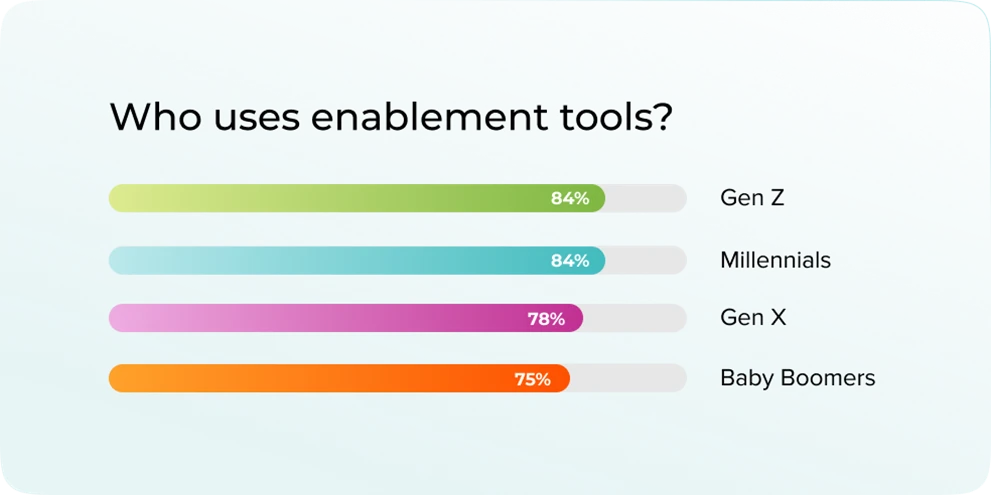Every professional – regardless of their field – has a tool they can’t live without. A carpenter can’t hone their craft without a hammer, while a mechanic can’t get anything done without a socket wrench. In B2B selling, go-to-market (GTM) professionals view enablement tools as mission critical to performing their daily tasks and driving strategic change.
With the ability to leverage data and insights, provide continuous learning and coaching, and streamline communication, enablement is a top priority for companies in 2024 and beyond.
Over the past decade, change agents have relied on enablement technology to break down silos and build bridges across functions to ensure their GTM teams perform at a high level. We wanted to know why, so we recently surveyed nearly 2,000 GTM leaders, spanning four generations and multiple industries around the world to understand the growing influence of enablement.
In the Generation Enablement Report: The Rise of Enablement’s Influence, you’ll find research on everything from the outcomes for users and non-users, to adoption challenges, and more.
If you’re ready to dive into the full report, you can download it here. If you’re not yet sure, this post highlights a few insights from the report, and you can always download it in full after you’re done here.
Who uses enablement tools?
The simple truth is that enablement technology is as popular as ever. In the survey, 82% of respondents reported using enablement technology to achieve a variety of goals – everything from revenue generation to customer satisfaction and operational excellence.
Perhaps most interesting is that at least 75% of each generation – from Baby Boomers to Gen Z – use enablement technology at work. With 84% of both Gen X and Millennial respondents reporting they use enablement technology, the future workforce is already familiar with enablement software.

Additionally, respondents across a variety of functions reported using enablement technology. 97% of companies use enablement technology across multiple departments, while 3% only use it with one team. The survey also found that 58% of marketers and 53% of customer success teams use enablement technology, demonstrating the growth of enablement tools beyond sales departments.
The difference between the haves and have nots
Several respondents reported using enablement tools to support their sales enablement strategy. And, for those who use sales enablement tools, 97% say it makes their jobs easier. Another 93% say it makes them more productive. It would seem that the “haves” have reaped the benefits of sales enablement.
Now, let’s look at the “have nots.” In the report, non-users felt that they wasted time on administrative tasks, while also feeling left in the dark. For example, 78% of non-users stated that they lack visibility into the progress of training and onboarding, while 75% responded that they lack visibility into team processes. And, most significantly, 73% of non-users responded that they struggle to help their teams achieve goals and/or serve their customers.
Amber Mellano
Enablement Director, Seismic Adoption & AI Specialist, Seismic
The future of sales enablement programs
Generation Enablement will only continue to increase momentum in 2024 and beyond. With the promise of efficiency, revenue generation, and productivity gains from artificial intelligence (AI), most respondents noted that their organizations will increase their investments in enablement tools.

Respondents also shared several reasons for increasing their investment in enablement technology. One of the biggest drivers: employee recruitment and retention. In fact, 76% of respondents believe their tools would help them attract new talent this year. Eighty percent of those who plan to increase or maintain their investment believe their enablement tools will help them retain more employees.
Yinyin Liu, Ph.D, Vice President, AI, Seismic
Some of the advancements within sales enablement platforms – namely AI – provide the basis for increased investment in these tools. According to report findings, 92% of respondents who plan to increase their investment in enablement tech plan to do so because of AI capabilities. Additionally, 79% of respondents said that AI-powered technology boosts productivity in the workplace.
Sidenote: AI is a hot topic, even in sales enablement processes. If you’d like to learn more about how your peers are using AI in their enablement strategy, download our report, The State of AI in Enablement.
Are you ready to be part of Generation E?
This is just a taste of what respondents shared in “The Rise of Enablement’s Influence.” To learn why new tech makes some colleagues feel uneasy or why adoption is a nagging issue, download the full report today!
